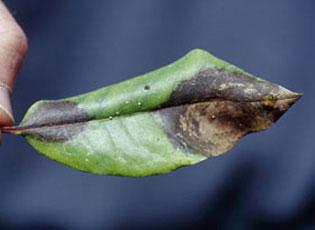Phytophthora ramorum Werres, de Cock & Man in't Veld (Kliejunas 2010)
Sudden oak death (SOD), ramorum blight, ramorum dieback
Unknown; first discovered in the U.S. and Europe at approximately the same time (Scianna et al. 2003)
1995 (Scianna et al. 2003)
Accidental
Potential loss of hardwood forest and increased potential of forest fire; impact to nursery and landscaping businesses (Scianna et al. 2003)

Symptoms, this leaf was confirmed as positive for P. ramorum by Jenny Davidson.
Joseph O'Brien USDA, Forest Service
Find more images
Spotlights
Distribution / Maps / Survey Status
Quarantine
Federally Regulated
Videos
All Resources
Selected Resources
The section below contains highly relevant resources for this species, organized by source.
Council or Task Force
Partnership
Federal Government
International Government
State and Local Government
Academic
Kliejunas, J.T. 2010. Sudden oak death and Phytophthora ramorum: A summary of the literature [PDF, 3.50 MB] (PSW-GTR-234). U.S. Forest Service, Pacific Southwest Research Station.
Scianna, J.D, M.K. Knudson, and J.A. Dickerson. 2003. Sudden Oak Death [PDF, 72 KB] (Plant Materials Technical Note No. MT-44). USDA Natural Resources Conservation Service.
 An official website of the United States government.
An official website of the United States government.